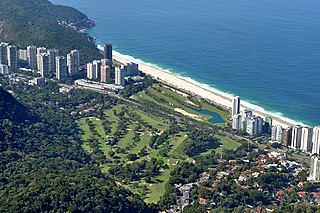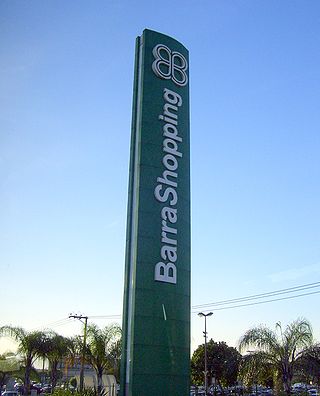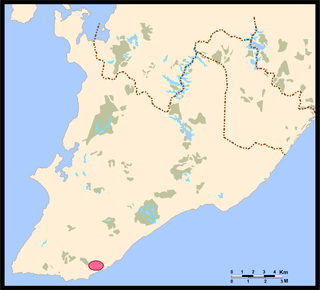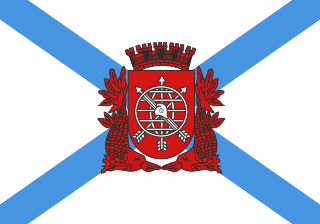São Miguel is the name of the largest island of the Azores and may also refer to:

Tijuca is a neighbourhood of the Northern Zone of the city of Rio de Janeiro, Brazil. It comprises the region of Saens Peña and Afonso Pena squares. According to the 2000 Census, the district has close to 150,000 inhabitants. It borders with Praça da Bandeira, Maracanã, Vila Isabel, Andaraí, Grajaú and Alto da Boa Vista neighbourhoods.

Barra da Tijuca is an upper-middle class neighborhood or bairro in the West Zone of Rio de Janeiro, Brazil, located in the western portion of the city on the Atlantic Ocean. Barra is well known for its beaches, its many lakes and rivers, and its lifestyle. This neighbourhood represents 4.7% of the city population and 13% of the total area of Rio de Janeiro.

Santana is a northern district in the subprefecture of Santana-Tucuruvi of the city of São Paulo, Brazil, and is located between 4–7 km (2.5–4.3 mi) from downtown São Paulo.
Avenida Brigadeiro Faria Lima, most commonly known as just Faria Lima, is an important avenue in the city of São Paulo, Brazil. It spans the upscale Pinheiros, Jardim Paulistano, Itaim Bibi and Vila Olímpia neighborhoods. It is also an important commercial and financial center that rivals the downtown and Paulista Avenue areas.

Tourism is a growing sector and key to the economy of several regions of Brazil. The country had 6.589 million visitors in 2018, ranking in terms of the international tourist arrivals as the second main destination in South America after Argentina and third in Latin America after Mexico and Argentina. Revenues from international tourists reached US$5.8 billion in 2015, continuing a recovery trend from the 2008–2009 economic crisis.

São Conrado is a neighborhood in the South Zone of the city of Rio de Janeiro, Brazil. It is nestled in between the neighborhoods of Barra da Tijuca to the southwest and Leblon to the northeast. The neighborhood takes its name from a small church, Igreja de São Conrado, which was constructed early in the 20th century by Conrado Jacob Niemeyer (1831–1905). São Conrado, which ranks as one of the areas with the highest Human Development Index in Brazil, presents a stark contrast to Rocinha on its border, which is one of the largest and poorest favelas in Brazil.

Barra Shopping is a Brazilian shopping center located in the Barra da Tijuca neighborhood of Rio de Janeiro. The center was opened in 1981.

Pituba is a large upper class neighborhood located in the southeastern zone of Salvador, Bahia. Its main routes, the Avenues Manoel Dias da Silva and Paul VI. Pituba's name is indigenous origin and means "breath, breath, sea".

The South Zone is an area of the city of Rio de Janeiro situated between the Tijuca Massif, the Atlantic Ocean and Guanabara Bay. Most of it is made up of neighborhoods along the Atlantic coastline, such as São Conrado, Vidigal, Leblon, Ipanema, Copacabana, and Leme.
Aldeia Campista was a neighborhood in Rio de Janeiro, Brazil, close to contemporary Vila Isabel, Tijuca, Maracanã and Andaraí.

The Tietê Bus Terminal is the largest bus terminal in Latin America, and the second largest in the world, after the Port Authority Bus Terminal in New York City. The terminal is located in the Santana district in the city of São Paulo, Brazil. The official name in Portuguese is Terminal Rodoviário Governador Carvalho Pinto, named after Carlos Alberto Alves de Carvalho Pinto, a former Governor of the State of São Paulo.

Alberto Arakaki AKA japa is a Brazilian professional vert skater. Japa started quad skating when he was 6 in 1978, practiced skateboarding until was 15, and went to bmx flatland from 15 to 18 years old. Them met aggressive inline skating at age 20 (1995) and turned professional in 1996. Japa has won many competitions in his vert skating career.

Iguatemi is the third largest Brazilian firm working within the fields of creation, planning, development, and administration of shopping centers after BRMalls and Multiplan. Iguatemi has shareholdings in 16 shopping malls, 1 premium outlet and 3 office towers that account for 657.000 m² of gross leasable area (GLA). Such space is used by 3.004 stores that welcome approximately 10 million customers per month.

Rio de Janeiro is on the far western part of a strip of Brazil's Atlantic coast, close to the Tropic of Capricorn, where the shoreline is oriented east–west. Facing largely south, the city was founded on an inlet of this stretch of the coast, Guanabara Bay, and its entrance is marked by a point of land called Sugar Loaf – a "calling card" of the city.

The following outline is provided as an overview of and topical guide to Rio de Janeiro:












